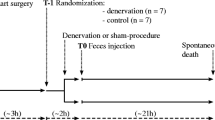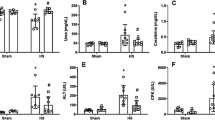Abstract
The effect of ulinastation on rat renal energy metabolism and blood flow in hemorrhagic shock was studied by31P nuclear magnetic resonance spectroscopy. Hemorrhagic shock was induced by withdrawing blood from the left carotid artery into a reservoir until mean femoral arterial blood pressure stabilized as 20 mmHg. Ulinastatin (50000 units·kg−1; UTI group, n=10) or saline (0.9% NaCl; NS group, n=10) was injected continuously during 30 min of hemorrhagic shock. Next, the total volume of blood shed in the reservoir was transfused into the right femoral vein over a period of 5 min. In the UTI group, 23.2±15.1% of adenosine triphosphate (ATP) remained and intracellular pH (pHi) was 6.77±0.07 at 30 min of hemorrhagic shock. However, ATP was not detected and pHi showed severe acidosis (pHi: 6.49±0.04) in the NS group. After the transfusion of shed blood, the UTI group exhibited higher ATP levels and pHi values than the NS group. Rats treated with UTI maintained mean arterial blood pressure and renal blood flow at significantly higher values than those administered NS.
Ulinastatin improved the energy metabolism of the shocked kidney. We believe that ulinastatin maintains mitochondrial function against hemorrhagic shock by its membrane-stabilizing actions and might contribute beneficially in hemorrhagic shock.
Similar content being viewed by others
References
Beard EL, Hampton JK Jr (1963) Effect of trauma on rat serum proteolytic activity. Am J Physiol 204:405–407
Aasen AG, Gallimore MJ, Ohlsson K, Amundsen E (1978) Alterations of plasmin activity, plasminogen levels and activity of antiplasmins during endotoxin shock in dogs. Haemostasis 7:164–169
Herlihy BL, Lefer AM (1974) Selective inhibition of pancreatic proteases and prevention of toxic factors in shock. Cire Shock 1:51–60
Ohnishi H, Suzuki K, Niho T, Ito C, Yamaguchi K (1985) Protective effects of urinary trypsin inhibitor in experimental shock, Jpn J Pharmacol 39:137–144
Gadian DG, Radda GK, Richards RE, Seeley PJ (1979)31P NMR in living tissue: the road from a promising to an important tool in biology. In: Shulman RG (ed) Biological applications of magnetic resonance. Academic, New York, pp 463–535
Seo Y, Murakami M, Watari H, Imai Y, Yoshizaki K, Nishikawa H, Morimoto T (1983) Intracellular pH determination by a31P-NMR technique. The second dissociation constant of phosphoric acid in a biological system. J Biochem 94:729–734
Adam WR, Koretsky AP, Weiner MW (1986)31P-NMR in vivo measurement of renal intracellular pH: effects of acidosis and K+ depletion in rats. Am J Physiol 251:F904-F910
Ozawa H, Takeda S, Ogawa K, Kanai H, Okino H (1978) Research for errors of blood flow measurement in electromagnetic flowmeters (in Japanese). J J M B (Japanese Journal of Medical Electronics and Biological Engineering) 16[Suppl]:224
Vogt MT, Farber E (1968) On the molecular pathology of ischemic renal cell death. Am J Pathol 53:1–24
Collins GM, Taft P, Green RD, Ruprecht R, Halasz NA (1977) Adenine nucleotide levels in preserved and ischemically injured canine kidneys. World J Surg 2:237–243
Warnick CT, Lazarus HM (1977) Adenine nucleotides during organs storage. Transplant Proc 9:1575–1577
Crowell JW, Jones CE, Smith EE (1969) Effect of allopurinol on hemorrhagic shock. Am J Physiol 216:744–748
Cunningham SK, Keaveny TV (1978) Effect of xanthine oxidase inhibitor on adenine nucleotide degradation in hemorrhagic shock. Eur Surg Res 10:305–313
Fernando AR, Armstrong DMG, Griffiths JR, Hendry WF, O'Donghue EPN, Perrett D, Ward JP, Wickham JEA (1976) Enhanced preservation in the ischaemic kidney with inosine. Lancet 1:555–557
Siegel NJ, Avision MJ, Reilly HF, Alger JR, Shulman RG (1983) Enhanced recovery of renal ATP with postischemic infusion of ATP-MgCl2 determined by31P-NMR. Am J Physiol 245:F530-F534
Lefer AM (1973) Blood-borne humoral factors in the pathophysiology of circulatory shock. Circ Res 32:129–136
Blattberg B, Levy MN (1965) Detection of reticuloendothelial-depressing substance in shock. Am J Physiol 209:71–74
Clowes GHA, Farrington GH, Zuschneid W, Cossette GR, Saravis C (1970) Circulating factors in the etiology of pulmonary insufficiency and right heart failure accompanying severe sepsis (peritonitis). Ann Surg 171:663–678
Proksch GJ, Routh JI (1972) The purification of the trypsin inhibitor from human pregnancy urine. J Lab Clin Med 79:491–499
Muramatu M, Mori S, Matsuzawa Y, Horiguchi Y, Nakanishi Y, Tanaka M (1980) Purification and characterization of urinary trypsin inhibitor, UTI68, from normal human urine, and its cleavage by human uropepsin. J Biochem 88:1317–1329
Gadian DG, Radda GK (1981) NMR studies of tissue metabolism. Annu Rev Biochem 50:69–83
Shulman RG (1983) NMR spectroscopy of living cells. Sci Am 248:86–93
Malbica JO, Hart LG (1971) Effect of adenosine triphosphate and some anti-inflammatory agents on a purified lysosomal fraction having high acid phosphatase and labile β-glucoronidase activity. Biochem Pharmacol 20:2017–2026
Wilkinson JH, Robinson JM (1974) Effect of ATP on release of intracellular enzymes from damaged cells. Nature 249:662–663
Hallak GJ, Wilkinson JH (1977) Action of adenosine phosphates on the release of intracellular lactate dehydrogenase from human and rat lymphocytes. Enzyme 22:361–369
Mellors A, Tappel AL, Sawant PL, Desai ID (1967) Mitochondrial swelling and uncoupling of oxidative phosphorylation by lysosomes. Biochim Biophys Acta 143:299–309
Mela L, Miller LD, Bacalzo LV, Olofsson K, White RR (1973) Role of intracellular variations of lysosomai enzyme activity and oxygen tension in mitochondrial impairment in endotoxemia and hemorrhage in the rat. Ann Surg 178:727–735
Fiskum G (1985) Mitochondrial damage during cerebral ischemia. Ann Emerg Med 14:810–815
Yoshikawa T, Murakami M, Seto O, Yoshida N, Takemura T, Tanigawa T, Miyagawa H, Morita Y, Tainaka K, Yokoe N, Sugino S, Kondo M (1988) Protective effects of a protease inhibitor, ulinastatin, on endotoxin shock and its scavenging effect on oxygen-derived free radicals (abstract in English). Masui (Jpn J Anesthesiol) 37:669–974
Author information
Authors and Affiliations
About this article
Cite this article
Ueki, M., Yokono, S. & Ogli, K. Effects of ulinastation on rat renal energy metabolism and blood flow in hemorrhagic shock. J Anesth 9, 65–69 (1995). https://doi.org/10.1007/BF02482039
Received:
Accepted:
Issue Date:
DOI: https://doi.org/10.1007/BF02482039




